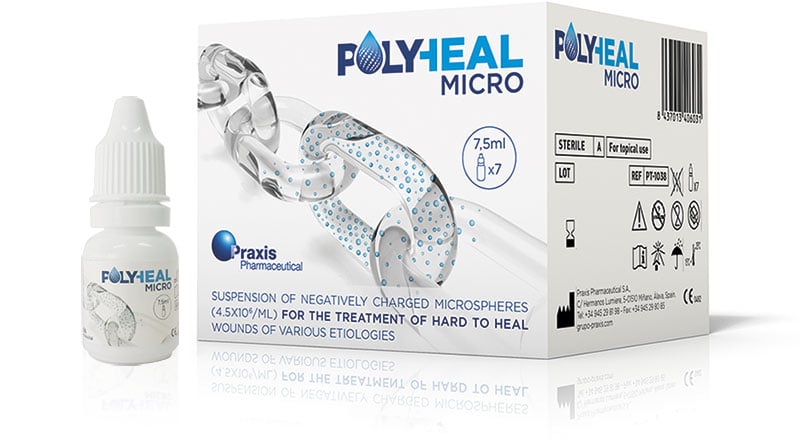WUWHS Congress 2022
Praxis Pharmaceutical will be present at the online platform created for the WUWHS 2022 Congress (Wo...
EventsPolyHeal® Micro is a liquid suspension that contains negatively-charged microspheres able to reactivate the wound-healing process in stagnant and hard-to-heal wounds from the very beginning of treatment, particularly in those with exposed bones and tendons.

The application of PolyHeal® Micro leads the patient’s own cells to reactivate the healing process and accelerates the formation of granulation tissue, favouring wound closure.1, 2
Quick and easy to apply, even in difficult access areas such as interdigital or cavitated wounds and it may be applied by the patient or by a caregiver with proper training.3
PolyHeal® Micro delivers a cost-effective treatment option for chronic ulcers and hard-to-heal wounds due to a reduction in treatment period, in the wound care expenditure and hospitalization burden.4

and accelerates the formation of granulation tissue favoring closure

to the proliferative phase, leading to patient’s own cells to reactivate the healing process

in exposed bones and tendons including stagnant hard to heal wounds

Reduction in wound care expenditure and hospitalization burdens
Negatively-Charged Microsphere Technology is based on polystyrene microspheres with a negative charge. Such charge increases the readiness by which cells may anchor onto the microsphere’s surface.
This cell attachment to the microspheres triggers a synchronised series of events that promotes the transition from the inflammatory phase to the proliferative phase, reactivating the healing process.

Negatively-Charged Microsphere Technology is based on polystyrene microspheres with a negative charge. Such charge increases the readiness by which cells may anchor onto the microsphere’s surface.
This cell attachment to the microspheres triggers a synchronised series of events that promotes the transition from the inflammatory phase to the proliferative phase, reactivating the healing process.
Chronic and hard-to-heal wounds have a major social impact. These wounds remain not healed for several weeks, leading to serious consequences for patient quality of life. The limitations derived from non-healing wounds include loss of mobility, patient dependence and difficulty in carrying out everyday life activities.
In order to facilitate the reactivation of the healing process, we have developed PolyHeal® Micro, an innovative technology with a unique mechanism of action. Its clinical efficacy has been proven in the treatment of hard-to-heal wounds and ulcers of different aetiologies, such as diabetic foot ulcers, vascular ulcers, pressure ulcers or post-surgical wounds.
With the proper training and support of a healthcare professional or caregiver, PolyHeal® Micro is a solution that can be applied quickly and simply. It promotes the reactivation of the stagnant healing processes and consequently reduces hospital admissions, thereby significantly optimising and improving patient treatment.
Our commitment to our patients consists of helping them to return home and get back to their day-to-day life as quickly as possible.
Effective wound care is becoming increasingly more relevant in the healthcare system due to the increase in the number of chronic wounds and associated comorbidities, as well as the ageing of the worldwide population.6 The estimated cost of providing care to patients with a non-healing wound is on average 135% greater than that of a healed wound.7
Moreover, chronic wounds generate a major social cost on the patient and on their environment. These wounds normally remain not healed for more than 6 weeks, in the course of which treatment is prolonged, leading to increased expenditure and impaired patient quality of life.
For this reason, our commitment with PolyHeal® Micro is to provide an innovative and cost-effective technology that optimises the management of chronic wound treatment, reducing the associated costs and delivering value across the healthcare chain. Furthermore, its proven long-term clinical efficacy and safety guarantees better results in a short period of time.

Chronic and hard-to-heal wounds have a major social impact. These wounds remain not healed for several weeks, leading to serious consequences for patient quality of life. The limitations derived from non-healing wounds include loss of mobility, patient dependence and difficulty in carrying out everyday life activities.
In order to facilitate the reactivation of the healing process, we have developed PolyHeal® Micro, an innovative technology with a unique mechanism of action. Its clinical efficacy has been proven in the treatment of hard-to-heal wounds and ulcers of different aetiologies, such as diabetic foot ulcers, vascular ulcers, pressure ulcers or post-surgical wounds.
With the proper training and support of a healthcare professional or caregiver, PolyHeal® Micro is a solution that can be applied quickly and simply. It promotes the reactivation of the stagnant healing processes and consequently reduces hospital admissions, thereby significantly optimising and improving patient treatment.
Our commitment to our patients consists of helping them to return home and get back to their day-to-day life as quickly as possible.

Effective wound care is becoming increasingly more relevant in the healthcare system due to the increase in the number of chronic wounds and associated comorbidities, as well as the ageing of the worldwide population.6 The estimated cost of providing care to patients with a non-healing wound is on average 135% greater than that of a healed wound.7
Moreover, chronic wounds generate a major social cost on the patient and on their environment. These wounds normally remain not healed for more than 6 weeks, in the course of which treatment is prolonged, leading to increased expenditure and impaired patient quality of life.
For this reason, our commitment with PolyHeal® Micro is to provide an innovative and cost-effective technology that optimises the management of chronic wound treatment, reducing the associated costs and delivering value across the healthcare chain. Furthermore, its proven long-term clinical efficacy and safety guarantees better results in a short period of time.
Praxis Pharmaceutical will be present at the online platform created for the WUWHS 2022 Congress (Wo...
EventsThrough our partner Aristo Pharma Iberia, Praxis Pharmaceutical will participate at the SEHER Congre...
Events